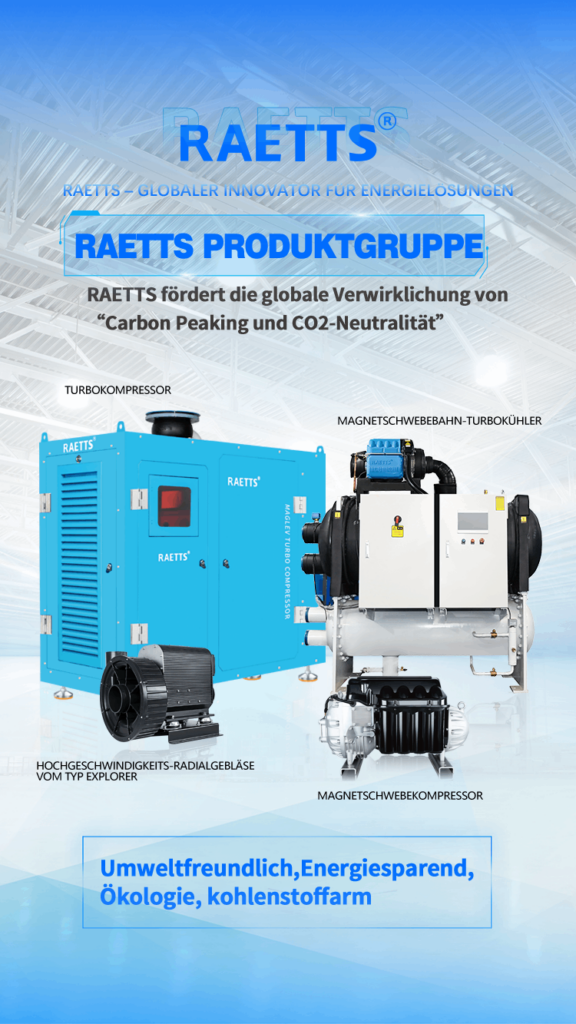Turbo blower systems are integral to various industries, offering powerful, efficient, and cost-effective solutions for air handling needs. Understanding the complete lifecycle of a turbo blower—from installation to replacement—is essential for maximizing performance, longevity, and return on investment. As a leading turbo blower manufacturer, RAETTS is dedicated to providing high-quality solutions that meet the unique demands of industrial applications. This article explores the stages of a turbo blower’s lifecycle, the critical aspects of each stage, and how RAETTS supports customers every step of the way.
The Lifecycle Stages of a Turbo Blower System
The lifecycle of a turbo blower system can be divided into several key phases: installation, commissioning, operation and maintenance, upgrades, and, finally, replacement. Each phase plays a significant role in the overall performance and efficiency of the blower, and proper management throughout the lifecycle is crucial for optimal results.
1. Installation: The Foundation of Efficient Operation
Proper installation is the first critical step in ensuring the longevity and efficiency of a turbo blower. At RAETTS, our turbo blowers are engineered with precision, but even the best equipment requires proper setup to function effectively. During installation, several essential factors must be considered:
- Site Preparation: Ensuring a suitable environment for installation, including ventilation, space for airflow, and accessibility for maintenance.
- Correct Positioning and Mounting: Properly positioning and mounting the turbo blower helps prevent issues related to vibration, noise, and energy inefficiency.
- Electrical and Plumbing Connections: Turbo blowers require precise electrical connections, and in some cases, connections to other systems like plumbing or ductwork.
RAETTS provides detailed installation guidelines and support to ensure that each blower is set up for optimal performance. Our team can also provide on-site assistance to oversee the installation process and verify that each component meets the required specifications.
2. Commissioning: Verifying System Readiness
Once installation is complete, the commissioning phase involves testing and verifying the system’s performance. During this stage, RAETTS engineers assess the turbo blower’s functionality, confirm its performance metrics, and calibrate settings based on operational needs. Key aspects of commissioning include:
- Performance Testing: Ensuring the blower operates at optimal efficiency by testing air output, pressure, and energy consumption.
- Calibration: Adjusting settings to match the specific needs of the application and achieve peak performance.
- Safety Checks: Conducting safety inspections to confirm that the turbo blower complies with all relevant standards and safety protocols.
Commissioning is a critical stage, as it identifies any issues before full-scale operation, preventing costly downtime and ensuring a smooth start to the blower’s operational life.

3. Operation and Maintenance: Ensuring Longevity and Efficiency
The operation and maintenance phase is the longest stage in the lifecycle of a turbo blower, often spanning several years. To maintain efficiency and prolong the lifespan of the system, routine maintenance and monitoring are essential. RAETTS offers several solutions to help customers achieve seamless operation and consistent performance.
Key Aspects of Routine Maintenance:
- Regular Inspections: Conducting regular inspections of components, such as filters, bearings, and impellers, to identify any wear or potential issues.
- Cleaning: Dust and debris accumulation can hinder blower efficiency. Regular cleaning of air filters and ducts helps maintain optimal airflow and prevent overheating.
- Lubrication: Bearings and other moving parts require adequate lubrication to reduce friction and wear.
- Monitoring Performance: Tracking operational data, such as airflow, energy consumption, and noise levels, helps identify trends and spot any performance declines.
RAETTS offers maintenance programs that include scheduled inspections, component replacements, and real-time performance monitoring. With preventive maintenance, RAETTS helps customers avoid unexpected downtime and costly repairs, ensuring the turbo blower continues to perform at its peak.
4. Upgrades: Adapting to Changing Requirements
Over time, operational demands and technological advancements may call for upgrades to an existing turbo blower system. RAETTS supports customers through upgrades that enhance efficiency, reduce energy consumption, and align with evolving industry standards.
Common Upgrades for Turbo Blower Systems:
- Control System Enhancements: Upgrading the control system can improve the blower’s precision and automation capabilities, allowing for better integration with modern industrial systems.
- Component Replacements: Replacing key components, such as impellers or motor systems, with newer, more efficient versions extends the blower’s lifespan and improves performance.
- Software Updates: New software updates may provide better system monitoring and control, allowing users to track energy usage, optimize airflow, and reduce downtime.
RAETTS turbo blowers are designed for easy upgrades, and our team is equipped to guide customers through the process of selecting and installing upgrades that best meet their needs.
5. Replacement: Planning for Long-Term Efficiency
The final stage in a turbo blower’s lifecycle is replacement. While RAETTS turbo blowers are engineered for durability, all systems have a finite operational life, especially as technology advances and industry demands change. Typically, the decision to replace a turbo blower is based on several factors:
- Decreased Efficiency: If a blower is consuming more energy or performing at reduced capacity, it may be time for a replacement.
- High Repair Costs: When repair costs begin to exceed the cost of a new system, replacement is often more economical.
- Advancements in Technology: As turbo blower technology improves, new systems can offer significant efficiency gains that make replacement financially worthwhile.
RAETTS provides an extensive range of turbo blowers for replacement, ensuring that customers can select a model that aligns with their current and future needs. Our team assists with system selection and offers trade-in options to help make the transition as cost-effective as possible.
RAETTS: Your Partner for Every Stage of the Turbo Blower Lifecycle
As a trusted turbo blower manufacturer, RAETTS is committed to supporting our customers throughout the entire lifecycle of their turbo blower systems. From installation to replacement, our services are designed to maximize efficiency, reduce downtime, and ensure long-lasting performance.
Why Choose RAETTS for Your Turbo Blower Needs?
- Industry Expertise: With years of experience in turbo blower manufacturing, RAETTS understands the unique demands of various industries and provides tailored solutions.
- Innovative Technology: Our turbo blowers are designed with cutting-edge technology, offering high efficiency, durability, and eco-friendly operation.
- Comprehensive Support: RAETTS offers full lifecycle support, including installation, maintenance, upgrades, and replacement, to ensure customers achieve the best possible results.
- Energy Efficiency Focus: RAETTS turbo blowers are engineered to minimize energy consumption, helping customers reduce operational costs and meet sustainability goals.
Conclusion
The lifecycle of a turbo blower system involves multiple stages, each with unique challenges and opportunities for optimization. By focusing on proper installation, proactive maintenance, timely upgrades, and strategic replacement, businesses can ensure their turbo blowers operate efficiently and reliably.
At RAETTS, we recognize the importance of a well-managed lifecycle for turbo blowers and are dedicated to supporting customers at every stage. Whether you are installing a new system, optimizing an existing one, or considering an upgrade or replacement, RAETTS is here to provide the expertise and advanced technology you need for a successful and sustainable operation.




